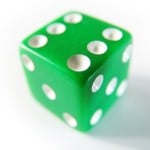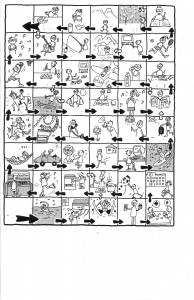 Practicing a new concept or new vocabulary always presents a challenge for me. I know that language is communicative – and that it is best learned/used in a communicative and purposeful setting. But sometimes I want a 15-minute focus on a particular point or a group of vocabulary terms. For that I often use a game that came from a textbook series (Obento) that I used to use. Essentially it is fun line drawings of everyday activities. (This generic picture game board is part of their blackline masters – and I am not posting it to be copied but to give you an idea of what it looks like.). A colleague asked me how I used this game and I thought I’d share. The more you use it, the more you see a place for it – for those times when you want a short focus on a specific element. The game is most heavily used in my Yr1&2 classes with some use (but more limited) in my Yr 3/4 ones.
Practicing a new concept or new vocabulary always presents a challenge for me. I know that language is communicative – and that it is best learned/used in a communicative and purposeful setting. But sometimes I want a 15-minute focus on a particular point or a group of vocabulary terms. For that I often use a game that came from a textbook series (Obento) that I used to use. Essentially it is fun line drawings of everyday activities. (This generic picture game board is part of their blackline masters – and I am not posting it to be copied but to give you an idea of what it looks like.). A colleague asked me how I used this game and I thought I’d share. The more you use it, the more you see a place for it – for those times when you want a short focus on a specific element. The game is most heavily used in my Yr1&2 classes with some use (but more limited) in my Yr 3/4 ones.
I use the game many ways and in two forms:
Form 1 – as a board game (with dice). Start at the bottom left and follow the dark arrows to the top left (finish) Form 2 – I cut out the individual squares of the game (I have 15 sets) so that we can use it in a ‘draw a card’ formatThere are two basic ways – either to practice a construction/conjugation or as a practice/conversation starter (supported by their follow-up questions sheet).
Conjugations (I know!) – If I taught a European language (which I don’t) – use the roll of the dice to determine what conjugation to give
– Land on square and the dice roll determines what you do – Dice roll 1 – “I” , roll 2 “you – informal”, roll 3 “he/she – singular” etc – Partner call – instead of using the roll of the dice – partner decides
– Option – pull a card and then roll dice or partner call
– Partner call – instead of using the roll of the dice – partner decides
– Option – pull a card and then roll dice or partner call
Verb tenses – – use the roll of the dice to determine what form to give
– Land on square and the dice roll determines what you do – Dice roll 1 – “did yesterday” , roll 2 “will do”, roll 3 “doing now” etc – Partner call – instead of using the roll of the dice – partner decides – Option – pull a card and then roll dice or partner callVocabulary
– Eg – words for “Places” – Roll the dice and land on a square and add a logical place that this activity could be done – Eg – “Temporal terms” – Roll the dice and land on a square and partner asks “Do you do this after school/on the weekend/before breakfast…”etcFrequency
– Land on a square and partner asks how often they do that activity – If they don’t – do they want to ‘why/why not’? – If they do it – use the follow-up questions to probe for detailsAbility
– Land on a square and partner asks if they can do that activity – If they don’t – do they want to try it? Why? Why not? – If they can do it – use the follow-up questions to probe for detailsReasons
– Land on a square and have to give a reason why you are or are not doing this activityWant to
– Land on a square and have to give a reason why you are or are not doing this activity – if they don’t – follow-up questions to probe as to whyReview
– At the end of the semester I use it for review – we put all the ‘things’ we learned how to say on the board (eg, ‘giving reasons’, ‘wanting to’, ‘~ing’ etc) usually there are about 10 main grammatical items – When they land on the square their partner calls out what they want them to do – * sometimes I also include things that we may have touched on but are not necessarily ‘part’ of the course. We call these the ‘challenge’ items and I encourage kids to go for them if they wantOnce you start using it in a variety of ways you begin to see other ways to use it. For 10-15 minutes its an option to ‘target’ learning.
Colleen

